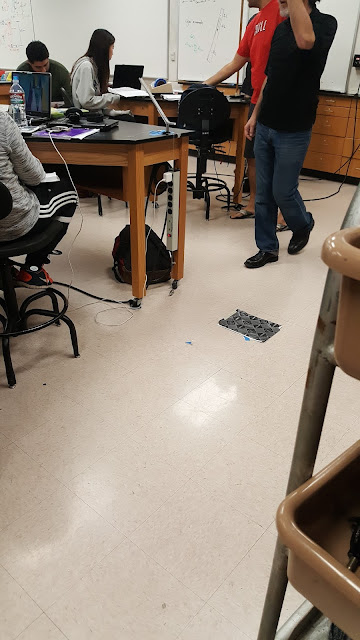Procedure: A ball was rolled down a ramp of known height, ball collided in-elastically with a perpendicular arm rotating about an axis. We found a value for the angular acceleration of the system with logger pro, and used it to find the value for the moment of inertia of the system. With the mass of the ball, velocity, and distance of impact from the axis of rotation, we were able to predict with good accuracy the angular speed of the system after impact. We were able to do this by relating the linear momentum of the ball to the angular momentum of the system.
The picture below shows how we determined the final velocity of the metal ball as it leaves the bottom of the ramp. This method is similar to how we measured the muzzle velocity of the cannon/gun in the "ballistic pendulum" lab. We positioned the ramp at the edge of the table, measured a vertical distance to establish a relationship with time, and a vertical distance to divide by the time the ball spends in the air to figure out the horizontal velocity.
Vf=1.35m/s.
Mass of ball = 0.0289kg
radius of ball = 0.0095m
Below are my calculations for the horizontal velocity of the ball as it leaves the ramp. (sorry for orientation of photo)
This picture below is of the setup. We hung a mass of 0.0246kg off of a pulley of radius 9=(0.0499/2)meters. The angular acceleration was then measured through logger pro and we found the average angular acceleration to be 5.6305rad/s/s.
We then equated torque to I*(alpha)
F*d=Iα
F=mg=0.0246kg*9.8m/s/s
d=(0.0499/2)m
α=5.6305rad/s/s
I=(after solving)=0.00105kgm^2
This is a graph of the raw data after the hanging mass was let go, and the two values from which we calculated an average value for the angular acceleration are shown on the two squares towards the bottom.
More Calculations:
Trial 1: The ball impacted at a right angle, and a distance 0.076m from the axis of rotation. We then used a similar equation to the one from before: m*v*d=Iω
"I" of the system had to be recalculated, which was just the one we calculated earlier, plus the moment for the ball+a parallel axis shift(which was equal to the distance from the center of the impact, to the axis of rotation).
I= 0.00105+(0.0289*0.076^2)+(0.0289*0.0095^2)*(2/5)
Distance from center of ball to axis of rotation = 0.076m
Experimental ω = 2.269 rad/s (as reported by logger pro)
Theoretical ω = 2.434 rad/s (as calculated)
Percent error: 6.78% Error
Trial 2:
I= 0.00105+(0.0289*0.042^2)+(0.0289*0.0095^2)*(2/5)
Distance from center of ball to axis of rotation = 0.042m
Experimental ω = 1.353 rad/s
Theoretical ω = 1.487 rad/s
Percent error: 9.01% Error
Conclusion: It is pretty cool to see that the only thing that is needed to relate linear and angular momentum is a radius for the linear momentum. Like other relationships between linear and angular quantities, such as velocity and acceleration, all that is needed is a radial quantity to relate angular and linear momentum. This is important because it shows that in this physical universe, different quantities can be equated relatively simply. A collision at half the radius of another collision will result in a quarter the angular momentum being transmitted. This is because of the parallel axis shift, which is related by the distance from the pivot-squared. Since m*v*r=Iω, the relationship between the angular momentum and the horizontal velocity of the ball is linear because the velocity is not squared in the relationship. The relationship between the angle of impact is related by a quantity of sin Θ, because only the perpendicular component transmits any momentum from linear to angular.
I learned that linear momentum times a distance = angular momentum.
Lab Partners:
Haokun Zhang
Christian Rivera






No comments:
Post a Comment